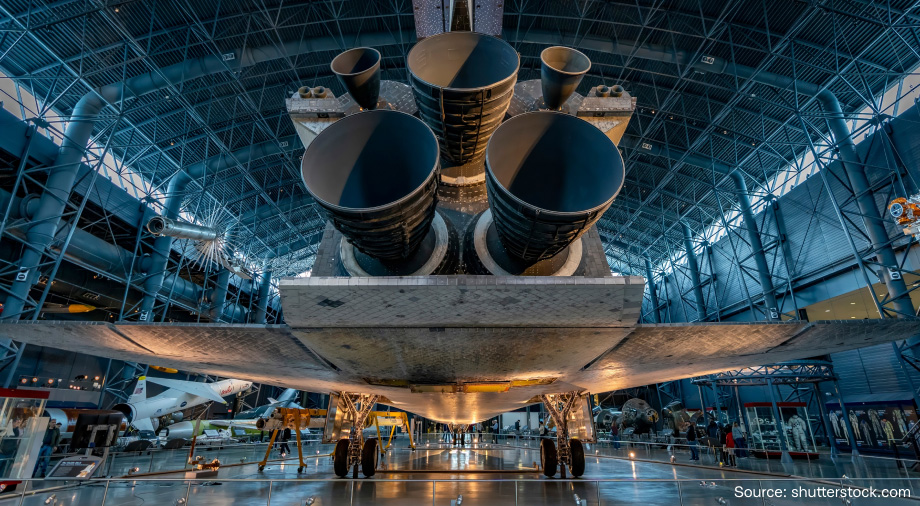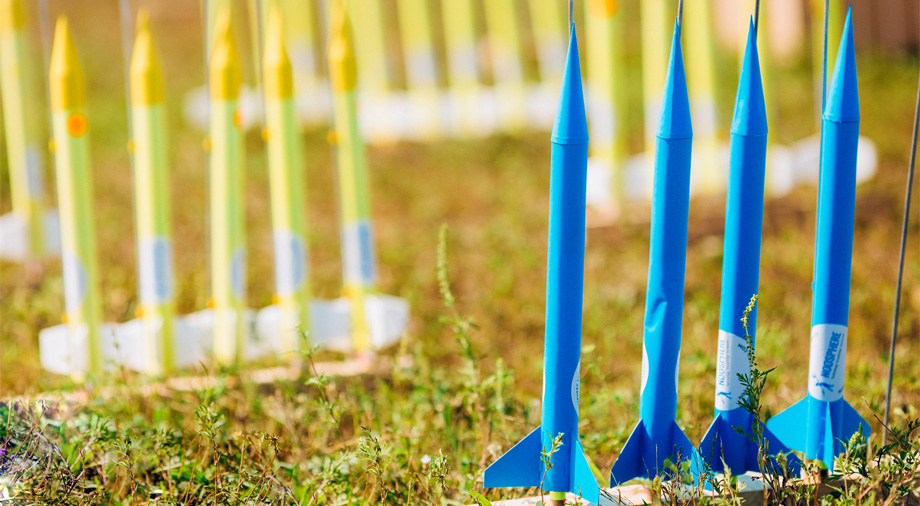The history of empirical space exploration is not so many years old. The first man-made spacecraft began to conquer orbit only at the end of the 50s of the last century, and only ten years later the first people visited outer space.
The relative youth of the field of aeronautics has had a very positive effect on the amount of material heritage that space research left as a legacy to its researchers. Rocket engines, real space shuttles and ships returned from the interstellar abyss and samples of extraterrestrial rock that they brought with them to Earth – this is not a complete list of what you can find in today’s rocket and space museums scattered around the world. Their expositions constitute a real planetary heritage of humanity, allowing us to visualize the entire span of development of the latest space era.
Houston, we have a problem: the tram is running late
When NASA Astronaut Jack Swigert uttered the iconic phrase, “Houston, we have a problem” during the infamous crisis aboard Apollo 13, he was calling back to the Johnson Space Center in Houston, TX. Hosting this expansive NASA facility made Houston one of America’s (and the world’s) most important space cities, and is even reflected in the name of the city’s baseball team, the Houston Astros.
Houston would let itself fall short as a space city if it lacked a world-class aerospace museum, and that’s where Space Center Houston comes in. The building was opened to visitors in 1992 after the Johnson Space Center’s administration decided to make the Space Center its own museum. The area of the museum is impressive – 23,000m2, and houses one of the largest space expositions in the US.
Space Center Houston is divided into several zones. The tour begins at the NASA Plaza pavilion, which hosts the museum’s main exhibition. The museum’s most legendary exhibits include a real space shuttle, as well as a collection of manned spacecraft including Mercury 9, Gemini 5, and the Apollo 17 command module. It also hosts a replica of the LTA-8 lunar module (better known as the LEM during the Apollo missions), which accompanied American astronauts on lunar missions.
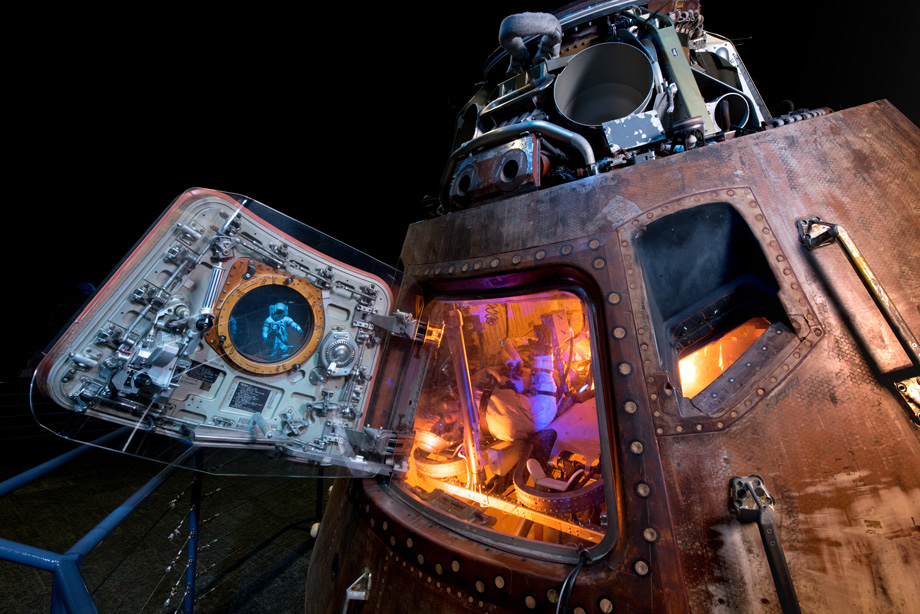
Source: Space Center Houston
In total, the Space Center Houston houses more than 400 exhibits. The largest of these are displayed in a large indoor hangar known as the George W.S. Abbey Rocket Park. It is here that the museum’s main rocket exhibition is presented, the most impressive exhibit of which is without a doubt the 3 stages of the legendary Saturn V rocket (namely flight versions that were not used). In the courtyard near the Rocket Park, you can also see a number of smaller rockets, in particular some of the first: Little Joe II, Mercury-Redstone, as well as Gemini-Titan.
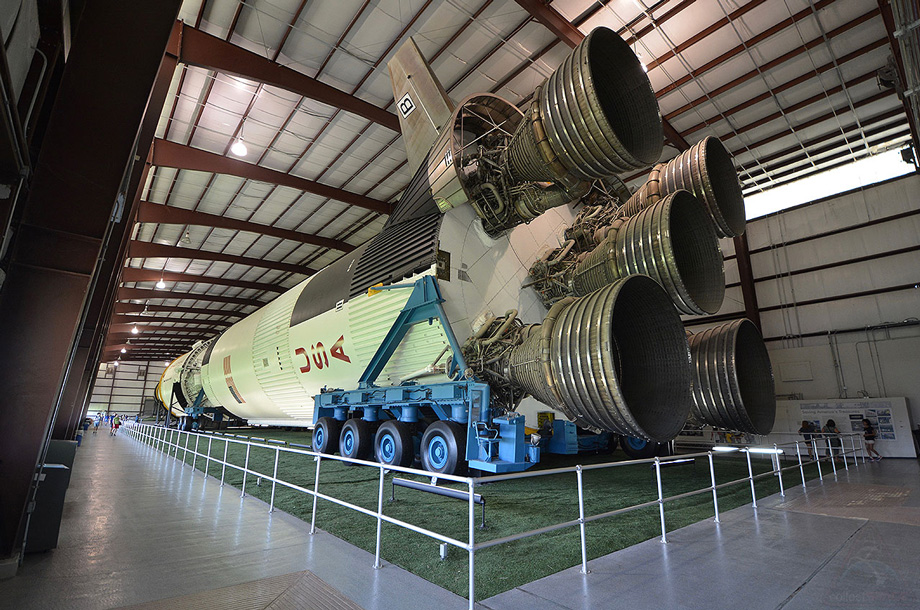
Source: collectspace.com
The area of Space Center Houston is so large that the museum even offers tours by mini-tram, which allows visitors to quickly grasp all the exhibits, moving between the main areas of the space museum. The tram tour route takes you to the Johnson Space Center, making several stops along the way, including Building 30 (NASA’s real-life Space Flight Control Room) and Building 9 (home to the Spacecraft Mockup Facility).
The museum also organizes numerous shows for children and adults dedicated to outstanding events and space dates. You can find an up-to-date schedule of upcoming events at Space Center Houston on the museum’s official website.
Legends of the Kennedy Space Center
When talking about Texas in the context of America’s space history, it is simply impossible to ignore another American state – Florida. The state’s Merritt Island is host to the Kennedy Space Center — which, since 1968, has been the main space flight control center and launch site for NASA.
The Kennedy Space Center visitor complex is also divided into areas dedicated to NASA’s main space missions. Here you can find the Race to the Moon Hall and the separate space of the Atlantis Space Shuttle dedicated to past missions of reusable spacecraft.
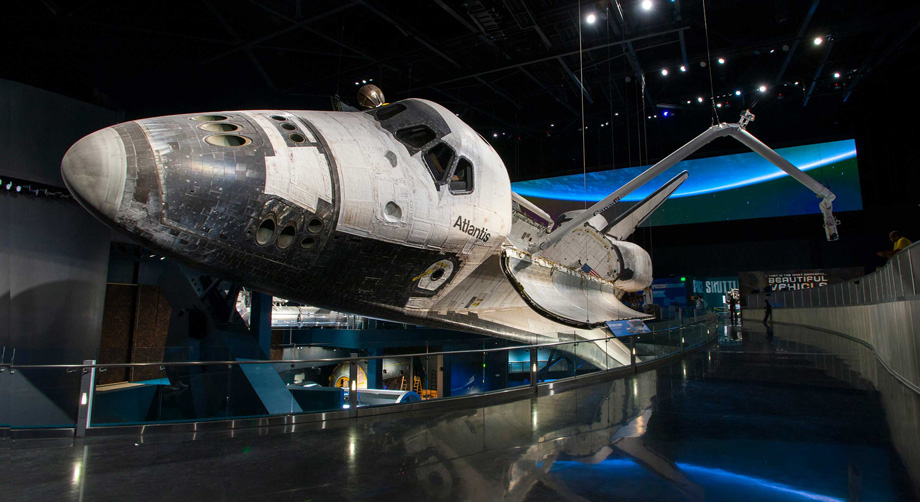
Credit: fmsp.com
Museum areas are dedicated not only to space inventions and technologies, but also to famous people. You can learn in detail about the life and professional careers of American astronauts by visiting the Astronaut Hall of Fame, which was started by the astronauts of the Mercury 7 space mission. Other names of rocket designers and outstanding NASA specialists can be found in the Hall of Heroes & Legends, which offers visitors the chance to feel like real astronauts in the Hero’s Eyes spherical 4D cinema. Here you can go on a short virtual space journey alongside Alan Shepard, Neil Armstrong, John Glenn, and James Lovell.
The entire exposition of the Hall of Heroes & Legends is built around the Mercury-Redstone rocket, with which NASA’s history of extraterrestrial travel began. In this hall, you can also find the Gemini 9 landing capsule, as well as the real Sigma 7 Mercury spacecraft in which the astronaut Walter Shirrah carried out his nine-hour orbital flight around the Earth during the last manned mission of the NASA Mercury program.
The Kennedy Space Center Visitor Center also has its own Explorer Rocket Park, but with a much larger display of launch vehicles than in Houston. Here you can see almost every rocket that launched from Kennedy’s launch pads throughout NASA’s golden decade in the 60s.
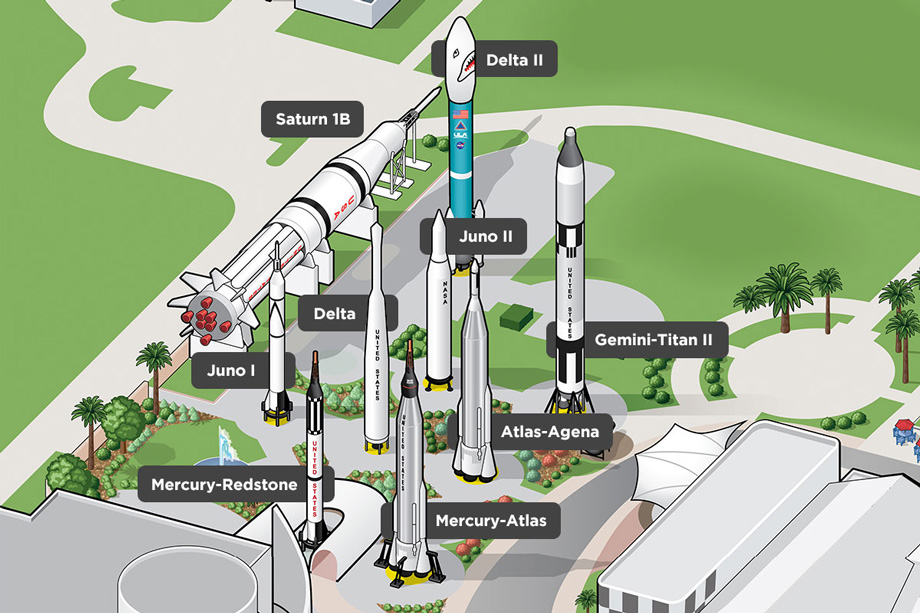
Image: kennedyspacecenter.com
The most famous rocket of the Apollo program, the Saturn V, is also present at the Kennedy Center. However, it is located not in the open space of the Explorer rocket park, but inside the museum.
Today, the KSC Visitor Center remains one of the largest rocket displays in the world. However, even here you won’t be able to see some of the legendary spacecraft that have become NASA’s hallmark. For this you, should visit Washington, DC.
Smithsonian National Air and Space Museum
The next entry on our list actually consists of two separate facilities. The original Smithsonian National Air and Space Museum is located in downtown Washington, DC and was opened in 1976 just days before America celebrated its 200th birthday. The second location, the Udvar-Hazy Center, is found right next to Washington’s Dulles International Airport. It was opened at the end of 2003, and holds a large number of iconic aircraft and spacecraft.
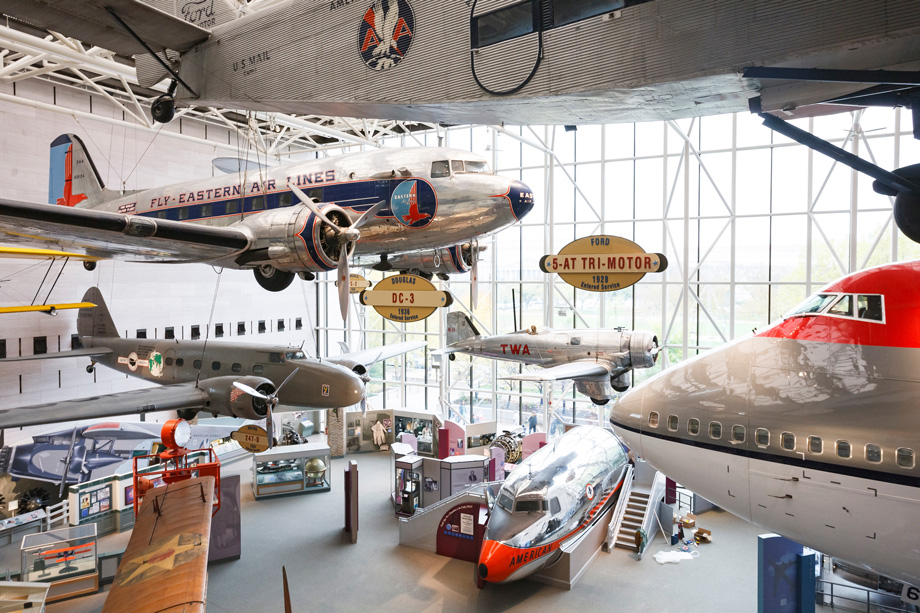
The downtown location specializes in educational exhibits (though with its own impressive collection of historical planes and spacecraft). Visitors are first invited to learn about how humanity first took to the skies with an exhibit on Oroville and Wilbur Wright’s first powered human flight, including the original 1903 Wright Flyer. Next comes an exhibit on the explosion of innovations that came during the early days of the aerial age, followed by an exhibit exploring the history of commercial aviation. Upstairs, the museum hosts an exhibit on America’s journey to the moon, as well as halls dedicated to the solar system and to the orbital satellites on which 21st century life depends. The Smithsonian Air and Space Museum also has the original model of the USS Enterprise used in the filming of the original series of Star Trek, a franchise which has inspired millions across generations to look towards the stars. Conveniently enough, the museum has its own means of looking towards the stars with an astronomical observatory with space telescopes. It is open to the public every day for several hours, as well as at night once per month.
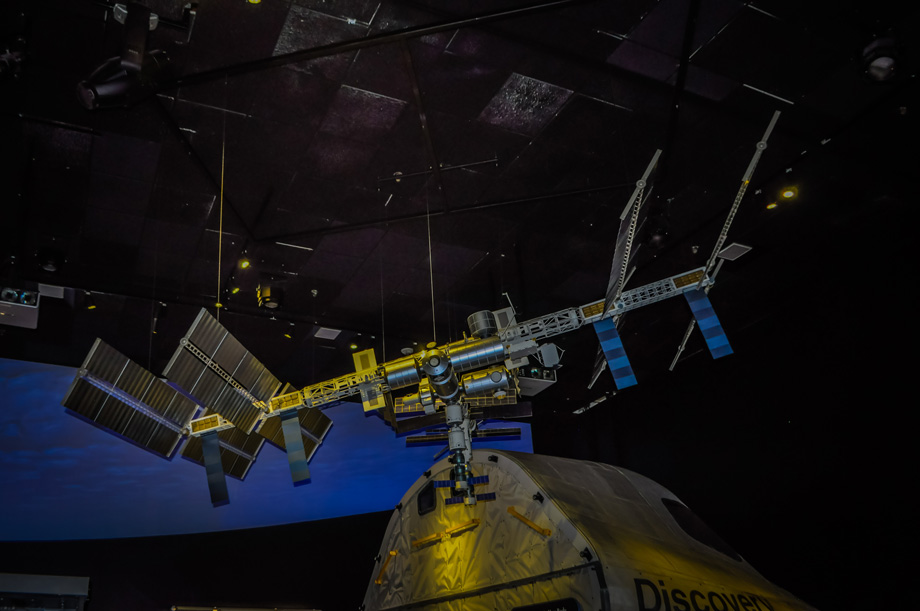
Source: shutterstock.com
The Udvar-Hazy Center in Virginia is known more for its world-class collection of hundreds of airplanes and spacecraft. Some of the highlights of its military aviation collection include the Enola Gay, the American B-29 Stratofortress bomber which dropped the atomic bomb over the Japanese city of Hiroshima, as well as an SR-71 Blackbird supersonic reconnaissance aircraft. The most impressive civilian aircraft at the center is an Air France Concorde supersonic passenger jet. However, space enthusiasts are sure to be most interested in the NASA Space Shuttle. When the Udvar-Hazy Center first opened, it hosted the Space Shuttle Enterprise, which served as an atmospheric test vehicle, but did not actually go to space. However, in 2012, the Enterprise was replaced with the just-retired Space Shuttle Discovery, which flew 39 missions into orbit between 1984 and 2011.
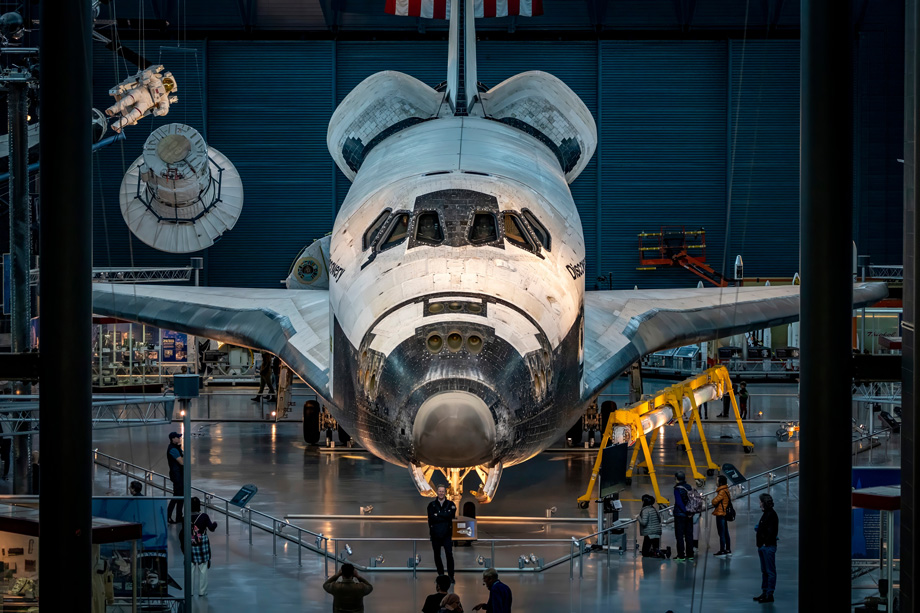
Source: shutterstock.com
The two locations are connected by an approximately 1.5-hour journey by public transport, but air and space enthusiasts will likely want to dedicate separate days to each one. As with all Smithsonian museums, admission to both locations is free (though the Udvar-Hazy Center charges for parking).
Without a doubt, the US holds the lion’s share of space artifacts from the past, but other space museums around the world also have something to show their audiences. On the territory of Europe, one of the largest space expositions was located in the vicinity of Paris and in the eastern part of the French city of Toulouse.
Cosmic France: “Space Town” and the MAE in Le Bourget
The European Space Agency (ESA) as we know it would never have been formed without the participation of France. It was the French aerospace company Arianespace in the late 70s that was responsible for the first European launch vehicle, the Ariane 1. Therefore, the French desire to honor their own space heritage makes total sense.
In June 1997, the Cité de l’espace (Space City), an exhibition area dedicated to space research, was opened in the outskirts of Toulouse. Some of the most impressive exhibits include a complete 55-meter replica of the Ariane 5 rocket, as well as a number of Soviet Mir and Soyuz orbital modules.
The Cité de l’espace museum places great emphasis on interactive exhibits. Thus, next to the replica of the Ariane 5 rocket, there is a model of the space control room, where every visitor can feel like a real space mission operator and be virtually present during all the procedures preceding the rocket’s launch: from the preparation of the flight equipment to the deployment of the satellite into orbit.
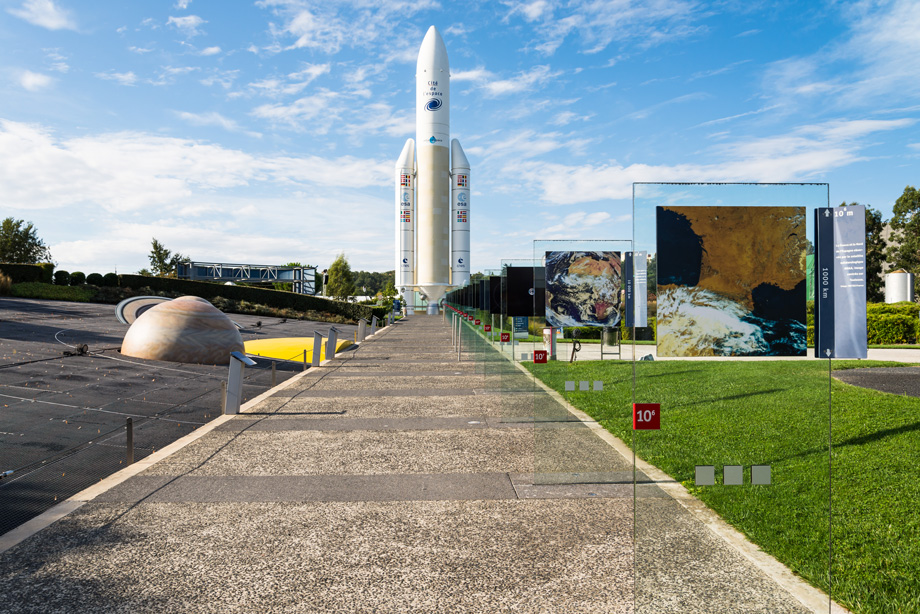
Source: shutterstock.com
The Toulouse space museum houses two planetariums, the largest of which (Astralia) can accommodate up to 280 visitors inside. The planetarium is equipped with a hemispherical screen with an area of 600 sq m, where the museum shows scientific films dedicated to the origins of the universe and other cosmic events. In addition to the planetarium, the Space City also houses a modern IMAX cinema, where you can see a movie with real footage from the repair of the Hubble Space Telescope (with a voiceover by Leonardo DiCaprio).
In 2013, the Cité de l’espace acquired a Martian meteorite, which became the centerpiece of the museum’s Martian exhibit, which was launched in 2002. Martian meteorites are surprisingly rare artefacts that landed on our Earth after Mars collided with another space body in the past.
Overall, more than 250 exhibits can be found in the exhibition pavilion of the Space Museum in Toulouse. This is a strong collection, but it does not compare to the more than 19,500 exhibits (not all space-related) spread across nearly half a million sq m at the other famous French aerospace museum.
Of course, we are talking about the Aviation and Space Museum (Musée de l’Air et de l’Espace, or simply MAE) in Le Bourget – one of the oldest air and space museums in Europe, which first opened its doors in 1919. Until 1973, its exposition was mainly located in the hangars of Chalet-Medony, on the western outskirts of Paris. When the further expansion of the museum’s collections demanded more space, it moved to the Le Bourget airport.
The extent of the MAE’s exposition is impressive, with its roster of aircraft alone reaching 150. Despite the fact that aviation is the lion’s share of the museum’s exhibits, in 2000, together with the opening of the reconstructed “Space Hall” and the updated planetarium building, the MAE began to attract a much larger number of space connoisseurs.
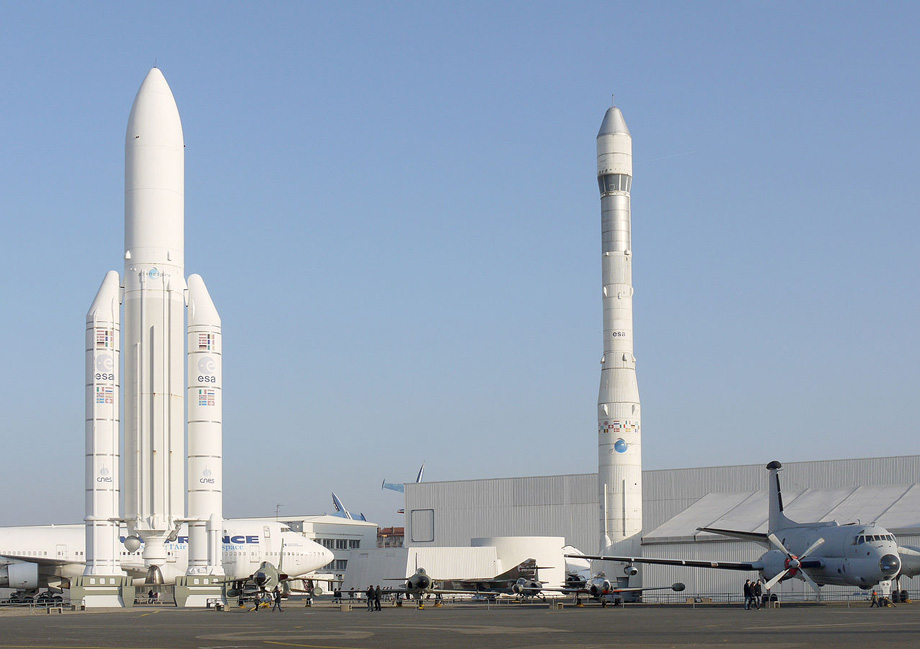
Credit: Pline / wikimedia.org
The rocket exposition of the Museum of Aviation and Space in Le Bourget contains more than just Arianes. Inside the museum’s space hall, you can also look at the first French liquid fuel rocket, the EA-41, developed in 1941. Next to it, you can see the rocket engine of the world’s first V-2 ballistic missile, developed under Nazi Germany. Also featured are the main parts of the French S3 medium-range ballistic missile, presented for viewing in segments.
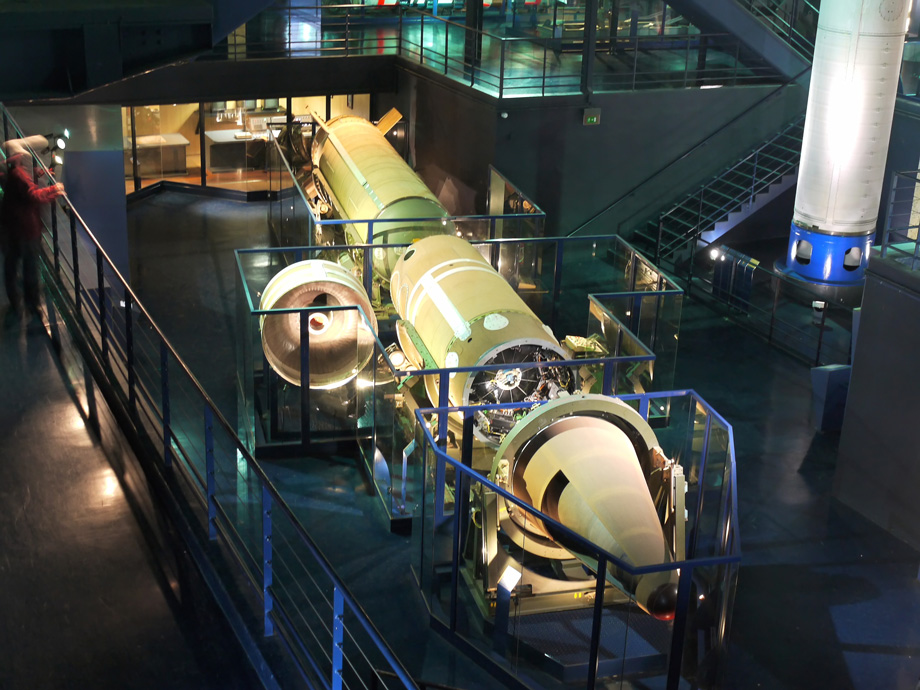
Credit: Pline / wikimedia.org
Another famous French rocket on display at the MAE, the Diamant-A, is famous for launching the first French satellite, the 39 kg Asterix, into low Earth orbit in 1965. The MAE places particular emphasis on satellites and space vehicles. Its collection includes replicas of the Soviet Sputnik-1, the Vostok-1 manned spacecraft (on which Yuri Gagarin made the first manned orbit of the Earth in 1961), the Lunokhod-1 space rover, the French civil monitoring satellite SPOT-1, as well as a copy of the Arabsat telecommunications satellite launched by the League of Arab States (on board a French Ariane 3 rocket) in 1985.
We can let you in on a life hack for visiting this amazing museum: if you go during the first week of the month, admission is free!.
Canada Air and Space Museum in Ottawa
Another French-speaking country on the other side of the Atlantic also has a fascinating space museum. Canada is not known for being a space power, but its space engineers have contributed to many inventions, most of which are concentrated in the Canada Aviation and Space Museum in Ottawa (Musée de l’Aviation et de l’Espace du Canada).
One of the most interesting exhibits of the museum is the Canadarm-201 robotic arm module, which was developed by Canadian specialists to conduct remote outboard activities during NASA space shuttle missions. The robotic manipulator arm on display in Ottawa was previously installed on the space shuttle Endeavour. After the Endeavour completed its flights and was decommissioned, Canadarm-201 was dismantled and shipped to its homeland.
At the museum’s presentation of the module, which took place on May 2, 2013, Canadian NASA astronaut Chris Hadfield, even dropped in to offer a few words. However, his visit was remote, as he was at the time deployed aboard the ISS.
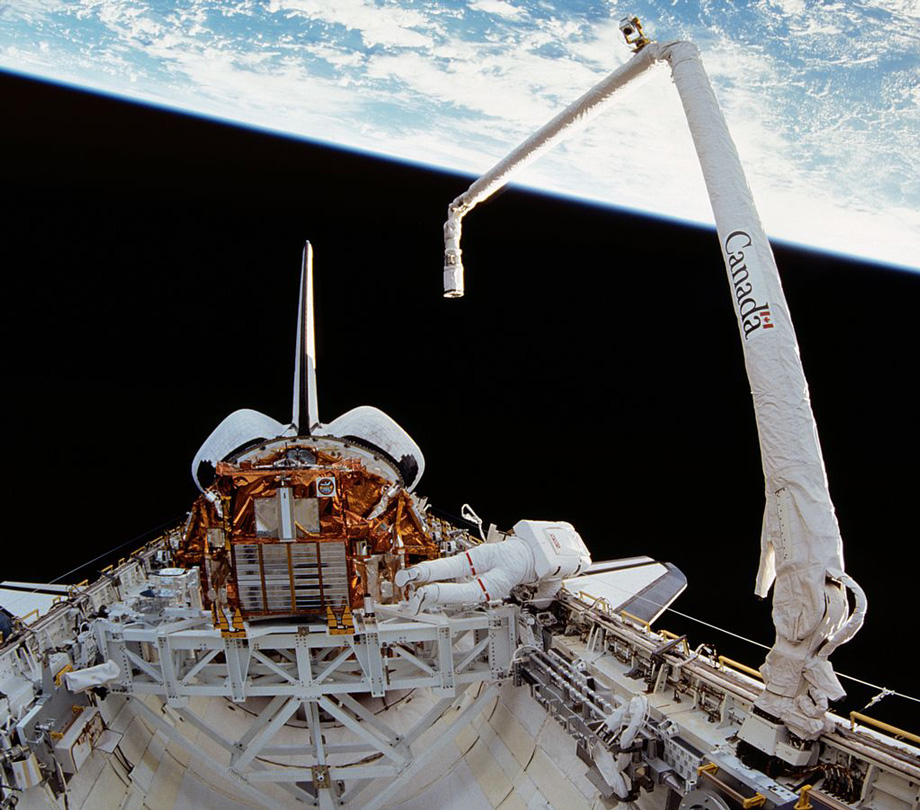
Credit: NASA
The Canada Air and Space Museum is also known for its permanent exhibition titled Health in Space: Daring to Explore, dedicated to Canada’s contribution to medical research in space. Canadian astronaut Dr. David Saint-Jacques, who was present as part of the ISS crew as a medical officer, was chosen as the main subject of the exposition. Visitors to the exhibition are invited to familiarize themselves with the equipment used during research, as well as to learn about the progress of medical experiments with the help of audio testimonies and text recordings of ISS crew members involved in these studies.
The most famous space museums of the PRC
Today, China is undoubtedly competing for leadership in the new space race, but this wasn’t always the case. Space enthusiasts can learn about the amazing history of China’s development as a leading space power at the Beijing Aviation and Space Museum. The museum was founded in 1985, and its total area is 8300 m2.
An entire floor of the Beijing Aviation and Space Museum, called Shenzhou Qiantang, is dedicated to China’s space history. It is divided into 5 separate expositions:
- Satellites and sensors – dedicated to the history of the development of Chinese satellites
- Rockets – follows the entire path of the PRC’s rocket engineering industry, and includes some samples of military ballistic missiles and civilian launch vehicles
- Manned Space – the exhibition tells about all the manned space missions of the China National Space Agency (CNSA) since 2003, when the first Chinese astronaut Yang Liwei reached orbit.
- Interactive zone – here visitors can step into the shoes of real astronauts, taking part in virtual tours and various simulators.
- Area for students – this space contains a large collection of scientific and popular science literature on space, which can be read by schoolchildren.
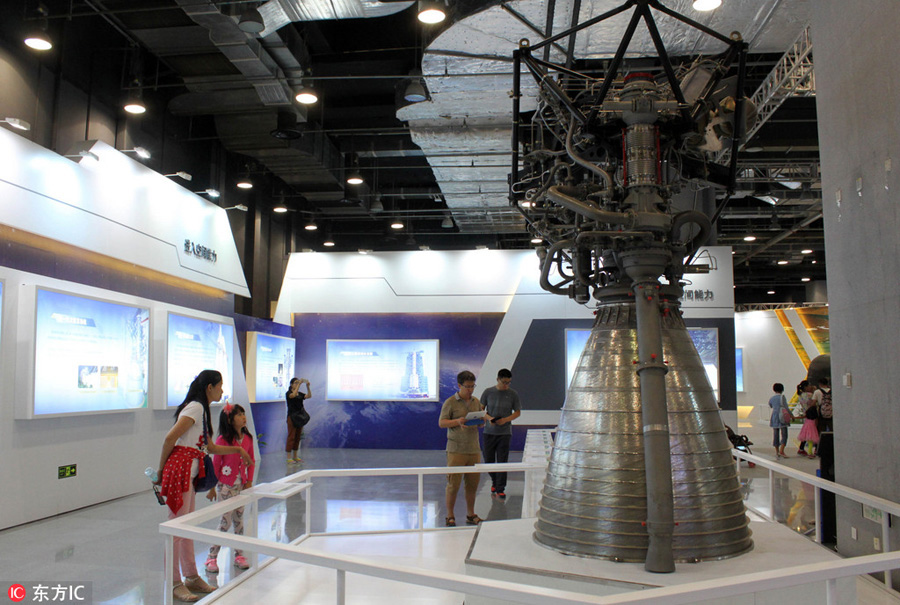
Credit: chinadaily.com.cn
The Beijing Aviation and Space Museum is an outstanding Chinese institution where visitors can learn about the space history of the Celestial Empire, but it is not the only one. In 1992, the China Aerospace Museum was opened in Beijing. Its exhibition halls are completely focused on space technology, in contrast to the large collection of aircraft found at the Beijing Aviation and Space Museum.
Among the China Aerospace Museum’s most interesting exhibits are the country’s unmanned lunar landing modules, as well as some samples of its manned spacecraft. In 2019, the museum building was closed for three years of major renovations. In 2022, the renewed exhibition of the China Aerospace Museum reopened its doors to visitors, offering previously unseen parts of its collection to the general public.
Some outstanding artifacts of Chinese space heritage can also be found at the China Science and Technology Museum (since 2016 known as the Beijing Science Center), which includes an entire hall of objects acquired over the past 50 years of China’s history in space.
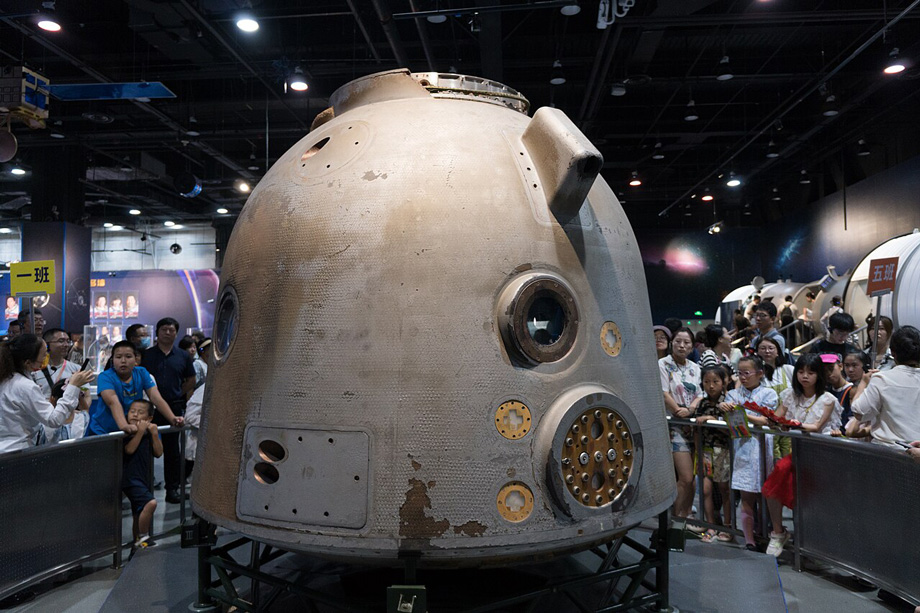
Credit: Shujianyang / wikipedia.org
Last year, a separate exhibition dedicated to space and astronomy opened at the Chinese Museum of Science and Technology. In its 2 sq km hall, you can find more than 30 exhibits and 10 scenes dedicated to various stages of the formation of Chinese space. Entrance to the new hall is completely free for all visitors, and it is also available in several foreign languages.

